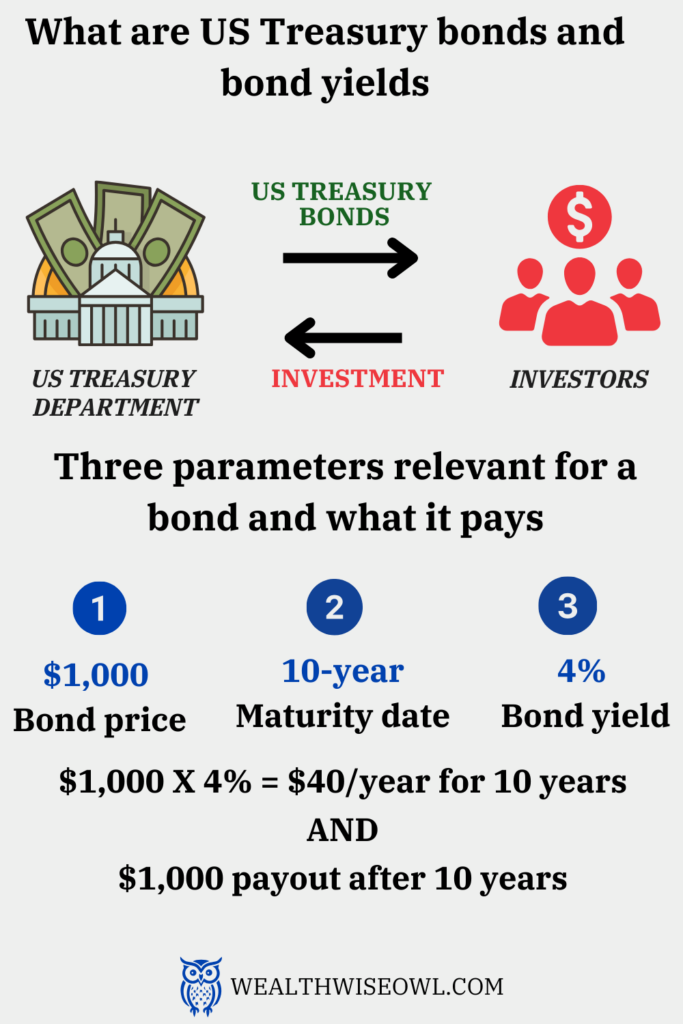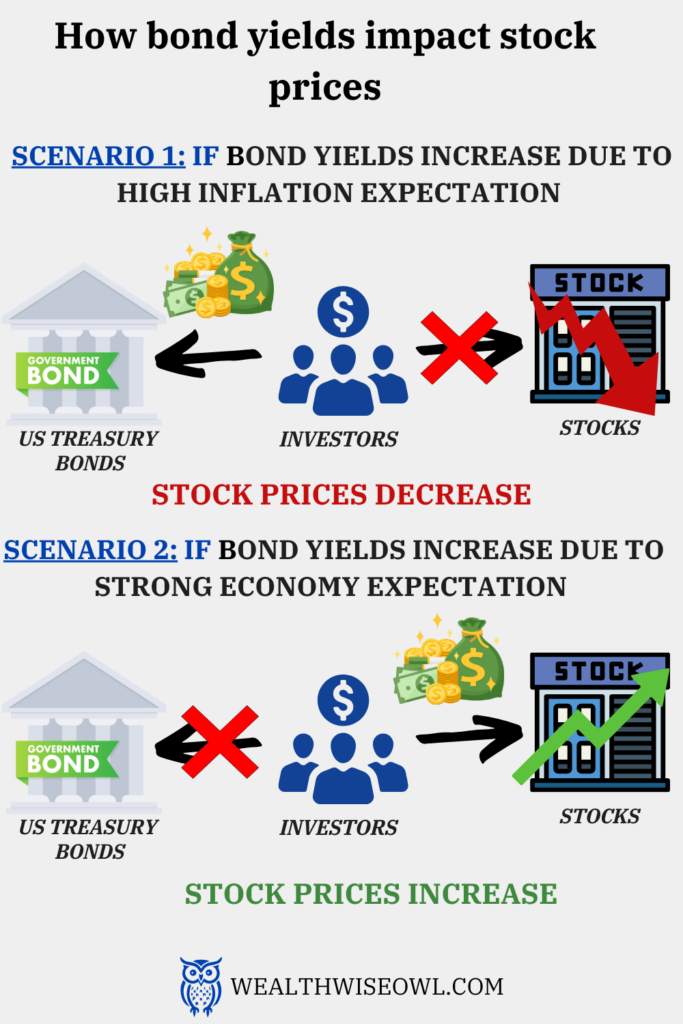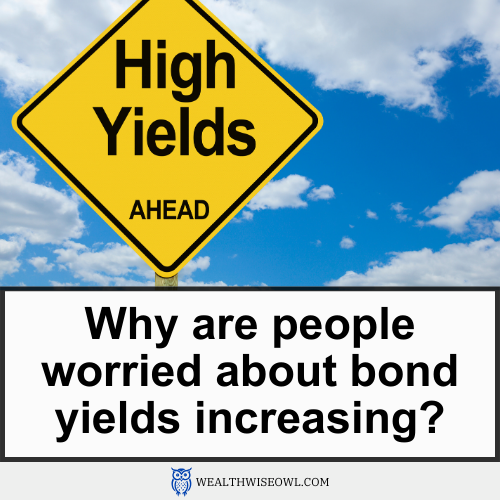Whenever the stock market falls or pulls back, I always hear the analysts pointing to bond yields as the cause. The rise in bond yields causes the stocks to fall is the commentary around these times. I have read a bit about how bond yields and stock market are related and in the process found that bond yields control almost everything under the sun. There is still a lot that I want to understand and dig deep into. I will share whatever I have understood and hopefully that also wets your appetite about this topic just the way it did for me. Let us listen into the conversation with Wealth Wise Owl.
Here are some resources that I used to learn more:
Relationship between bond prices and interest rates | Finance & Capital Markets | Khan Academy
What Rising Treasury Yields Mean for the Economy
How The Yield Curve Predicted Every Recession For The Past 50 Years
What is the Yield Curve, and Why is it Flattening?
Use these quick links to jump to a section of your interest
Conversations with Wealth Wise Owl

Helloo my friend! How has the start of the year been for you?

Hi there! It has been great for me so far. I am making good progress on my resolutions so far and want to keep the momentum going.

That is amazing! I am also doing the same and doing good on learning more about how the stock market works. Recently, I read about the impact bond yields have on stock prices, which was very intriguing and something I wanted to understand more about.

It is an important topic that you bring up and bond yields are key to a lot of things including stock prices. We had talked about how mortgage rates are determined and the bond yields were an important factor there too.
[Check out this blog to learn more about how mortgage rates are determined]
To understand the relationship between bond yields and stock prices, you need to know that both stocks and bonds are different types of assets and all assets compete for investors’ money. If one asset seems favorable than the other then that is where the money flows to. The more favorable asset has a higher demand and hence sells at a higher price. If you remember this it will help with what we will talk about later.

That makes sense, stocks and bonds are competing for the same money. If one is more favorable in terms of higher returns then investors will demand more of that asset and raise its prices due to supply-demand balance. I understand the returns on stocks are based on the rate of increase in their prices and/or dividends they offer. But the returns on bonds are less clear to me and how are their yields determined.

Yes, stocks are more popular than bonds because of the excitement they create from the stories of individuals getting rich from owning/trading in them. That is why people learn about them and have a good sense of why stock prices go up or down. Usually, if the business behind the stock does well then the stock prices go up because it attracts investor’s attention and money.
Before we discuss why bond yields increase or decrease, let us understand what bonds are and what does bond yield even mean.
When people talk about bonds, they are usually referring to the US Treasury bonds. The US Treasury department issues bonds to get money for the US government to spend if it does not have enough. So, the bonds are just like a debt for the US government that they need to pay back with interest. Based on how long the term of the debt or loan is, there are different types of bonds. The longer the term of a bond or also known as its maturity, the higher interest rate it demands and this interest rate is what determines bond yields. Going forward I will use the term interest rates and bond yield interchangeably because they mean the same thing.
The reason that longer term bonds have higher interest rates is because the lenders demand a higher rate of return for lending their money for a longer time. This higher interest rate compensates for the greater risk the lender has taken because he/she may forgo a better investment opportunity during the loan term.
For example if a $1000 bond has a maturity in 10 years time and has a 4% yield, it means that this bond pays 4% of $1000 i.e. $40 every year till 10 years and after 10 years you will get back $1000. A bond with a maturity date in 5 years will have a lower yield, say 3%, because there is less risk in a lower loan term.
US Treasury issues bonds that have maturity ranging from less than a year all the way to 30 years and they are also called different names. Treasury bills are bonds issued for less than a year, Treasury notes range from 2 to 10 year maturity dates and Treasury bonds have either 20 or 30 year maturity dates. All the bonds are auctioned on the US Treasury website, where they can be bought in multiples of $100. The price of the bond and its interest rates or yield are decided at the time of the auction. The investors, who can be individuals, investors or even foreign governments take into account multiple factors when they bid for the bonds. So, essentially it is these investors that are controlling the bond yields and if we can understand what governs their decisions we may get a grip on why the bond yields go up or down.
It is also important to understand the relation between bond price and bond yield. Let’s continue the example from above where we have a bond that was purchased for $1000 and had a 4% yield. Let’s say due to increase in the Federal funds rate or other economic factors, the investors demand a higher yield. Now, if the yield goes above 4% then the $1000 bond that we hold will not be attractive due to its lower yield. Less attractive means lower demand and that would mean a lower price. So, to compensate for the lower yield, the price of the bond that we hold will go down. This will not affect the fixed interest payments of $40 that we were promised nor will it affect the $1000 that we will get after 10 years if we decide to hold onto the bond till maturity. However, if we feel like we need to sell this bond and get the new bonds that have a higher yield, then we would have to sell this at a discount and we will not get the entire $1000 back that we put in. So, basically if the yields on bonds increase due to investor demands, the price of the existing bonds will decrease and on the other hand if the yields decrease then the existing bonds will become more valuable and their prices will increase. It is not just the yield% that decides the price but it can also be the other way around. If the supply of bonds increases drastically due to investors selling them for other opportunities, then their prices would go down and as a result their yields would increase. Overall, there will always be an inverse relationship between bond prices and bond yields.


Okay, so far I have understood that bonds are a form of debt that either a company or government agency issues to meet their expenses. Like any loan, just like a car or home loan, there is an interest rate that needs to be paid on the bonds. These interest rates are higher for longer term bonds because the lender is taking a higher risk. For the US Treasury bonds, the interest rates are set by the auction, where investors bid for the bonds. Based on the yields of the new bonds, the prices of existing bonds fluctuate. An increase in yields will lower the price of the bonds and decrease in yields will increase their prices.
You mentioned that there are several factors that the investors look at to decide how much interest rate they would demand from the bonds, what are these factors?

Your summary was excellent about the bonds and their interest rates. Now if we talk about what the investors look at to decide bond yields in the auction, we need to look at the following factors:
1. Monetary policy : This includes the Federal Funds Rate set by the Federal Reserve Bank and their policy for future rates. If the Federal Funds Rate is low and it is expected that they will be low over a longer period, then the expectation of interest rates from long term bonds is also lower. This is because the Federal Funds Rate impacts the short term borrowing rate between banks and even other short term bonds like the yield% of Treasury bills, which have a maturity of 1 year or less. Investors have a choice to make, either they can keep buying the 1-year Treasury bills over several years or they can buy a long term bond like a 10-year Treasury note. They know that there is less risk in the 1-year Treasury bills or other equivalent short term bonds as there is more certainty on the interest rates. So, they add some premium over these short term rates to set their expectations of yield% from a 10-year Treasury note. This is how the interest rates or yields for long term bonds are influenced by the monetary policy around the Federal Funds rate.
2. Fiscal Policy : This affects economic growth and inflation. It also determines how much debt the government will have as it will impact the Federal budget. A high deficit in the budget or expectation of a high deficit would mean more pressure on the US government to get debt to meet this deficit. To incentivize investors to give money to the US government, the yield% on the Treasury bills, notes and bonds will be higher.
Another way to understand the impact of debt is looking at how interest rates for our home loans are decided based on our debt to income ratio. If we carry a lot of debt in car loans, student loans, credit card debt, etc. then we seem like a risky borrower and the lender charges us a higher interest rate to compensate for that risk. Similarly if the US government is seen to carry a lot of debt and there are signs that it is only going to get worse then investors would also demand a higher interest rate on the bonds.
There are also political factors or relationships with foreign governments that impact the yield on the bonds. The foreign government holds reserves of US currency, which is usually in the form of bonds, since the US dollar is the reserve currency for international transactions. US has used this power to impose sanctions on foreign countries by freezing these bonds and essentially cutting off the ability to trade in US dollars. These foreign countries have now started to conduct transactions in other currencies and move away from the US dollar. By ditching the US dollar, they are not buying the US Treasury bonds anymore, which reduces the price of the bonds due to lower demand and as a result increases their yield.
3. Economic growth : A high rate of economic growth or strong economy would tempt investors to buy equities rather than bonds due to expectations of higher returns. This would reduce the demand for bonds, like the 10-year Treasury notes, and the yield% on bonds would increase. If the economy is weak, then the investors would look for safe investments like bonds, which will increase their demand and, as a result, reduce the yield% on them. Therefore, when we see that the yield% on long term bonds like the 10-year or 30-year starts to decrease then it signals that the economy is slowing down could be heading into a recession. A popular term that the financial analysts use to predict recessions is the inverted yield curve, which essentially means that the yield% on long term bonds decrease so much that they become lower than the short term bonds. This would not happen if the economy is running smoothly and the future looks promising because in that scenario the yield% on longer term bonds will always be higher as there is more risk involved. What an inverted yield curve says is that the long term risk is less compared to the immediate risk of an economic slowdown or recession.
4. Inflation : Inflation eats away the buying power of money and to preserve the buying power, investors look for investments that have returns higher than at least the inflation. This expectation of higher returns in a high inflation environment also applies to the bonds. Hence, the yield% from the bonds increases in a high inflation environment or even the expectation that the inflation would rise in the future.

That was very interesting! There is so much that goes into the price and yield of bonds. It looks like anything and everything that can impact the economy or financial environment, especially in the US, will impact the bond yields of the US Treasury bonds. Just by looking at how the bond yields behave we can assess the investor sentiment about the economy in general. I bet this also spills over to the fluctuations we see in the stock market, correct?

You hit the nail in the head! Like we discussed the other day, stock prices are strongly influenced by investor psychology and the best barometer for investment psychology is the bond yields. As we saw that there are several factors that influence the bond yields and if we understand what is the deciding factor then we can estimate the impact on the stock market.
[Check out this blog to understand how stock prices are determined]
For example, let us say that the long term bond yields increase and now look at the impact on stock market based on what the deciding factor is:
- High inflation: If the investors expect the inflation to be high either due to proposal of tax cuts that increases the disposable income or higher tariffs that raises the price of the goods, they would want a higher return from their bond investments to protect against the higher inflation rate. Another way to look at higher inflation expectation is that the Federal Reserve would increase the short term interest rates to bring down inflation and this could also raise the interest rates on long term bonds. Now, because the investors expect the near term interest rates to increase, they would forecast that money would be hard to borrow for businesses and individuals. This would mean that spending in the economy would decrease and it would be bad for the businesses as it would reduce their earnings. As we talked last time, stock prices are influenced heavily by the earnings, so a decrease in earnings would also reduce the stock prices.
- Strong economy: If the investors feel that the economy would be strong in the future then they would prefer to put their money into other assets than bonds. This would reduce the demand for bonds and reduce their prices, which in turn would increase their yields. Since the investors feel that the economy will do well i.e. businesses will have good earnings, they will buy into their stocks and stock prices would increase.
What we saw here is that the bond yields increase can either increase or decrease the stock prices based on what factor has caused the bond yields to increase. The same can be said about a decrease in the bond yields. Having said this, It is very difficult to know exactly why the bond yields go up or down as it could be a combination of different factors and not just one factor. Therefore, it is anyone’s guess what impact change in bond yields will have on the stock prices. But at least now you understand the complexity behind the relation between bond yields and stock prices.


I definitely can appreciate the challenge of pinpointing the exact reason why the bond yields go up or down. There are events at global scale or even the local scale that can cause this. What I have taken away from our discussion is to know what things to look at when the bond yields fluctuate and the reasoning that the financial analysts used would make more sense now. This discussion has been immensely captivating for me and I have learnt a lot today. I cannot wait for the bond yields to change and try myself to predict why that happened, hopefully every time it bodes well for my stock portfolio!


